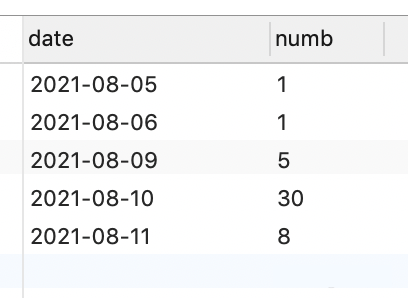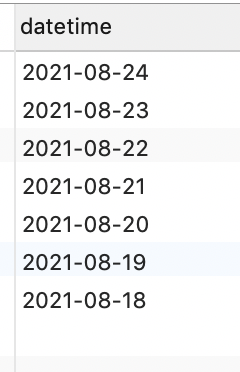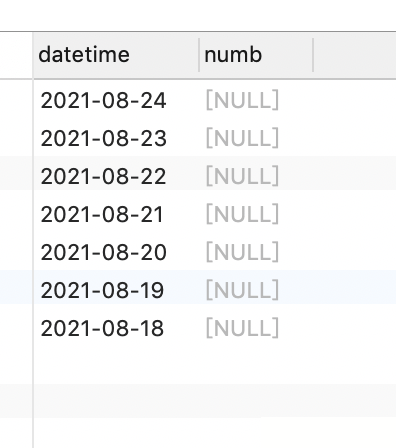How to generate consecutive dates and variable assignments in mysql
1. Production consecutive dates
Explanation: Mainly used for some statistical data to display in chronological order;
If the database data has data for the next day, the statistics will not If it needs to be displayed every day, even if it is 0, then a timetable must be generated for use;
Query database data:
SELECT
DATE_FORMAT( create_time, '%Y-%m-%d' ) AS date,
COUNT(1) AS numb
FROM
qc_task
WHERE
create_time>= DATE_SUB(CURDATE(),INTERVAL 1 MONTH) and
department_id IN ( SELECT id FROM `vigilante_jinan`.`qc_department` WHERE `area_code` = (@dep_BH) AND `status` = '1' AND dept_level >= (@dep_DJ))
GROUP BY DATE_FORMAT( create_time, '%Y-%m-%d' )Output the next day Data:

Doesn’t this look good? If you have to add an order by 1 desc to arrange it, you can also...
But even if When discharged, the time is also inconsistent;
Generate the dates of the last 7 days:
// 方法笨,但还是有效的
select DATE_FORMAT(SUBDATE(NOW(), interval (timeList.sj*1460) MINUTE),'%Y-%m-%d') as 'datetime' from
(SELECT @num:=@num+1 as sj from
(SELECT 1 UNION SELECT 2 UNION SELECT 3 UNION SELECT 4 UNION SELECT 5 UNION SELECT 6 UNION SELECT 7) t,
-- (SELECT 1 UNION SELECT 2 UNION SELECT 3 UNION SELECT 4 UNION SELECT 5 UNION SELECT 6 UNION SELECT 7) t1, -- 假如嫌弃生成的少,打来这个就行
(SELECT @num:=0) y) as timeListGenerate time:

Use after generation:
-- 生成后左右链接即可,但主表要为时间表
SELECT f.datetime, t.numb FROM
(SELECT
DATE_FORMAT( create_time, '%Y-%m-%d' ) AS date,
COUNT(1) AS numb
FROM
qc_task
WHERE
create_time>= DATE_SUB(CURDATE(),INTERVAL 1 MONTH) and
department_id IN ( SELECT id FROM `vigilante_jinan`.`qc_department` WHERE `area_code` = (@dep_BH) AND `status` = '1' AND dept_level >= (@dep_DJ))
GROUP BY DATE_FORMAT( create_time, '%Y-%m-%d' )) t
right join
(select DATE_FORMAT(SUBDATE(NOW(), interval (timeList.sj*1460) MINUTE),'%Y-%m-%d') as 'datetime' from
(SELECT @num:=@num+1 as sj from
(SELECT 1 UNION SELECT 2 UNION SELECT 3 UNION SELECT 4 UNION SELECT 5 UNION SELECT 6 UNION SELECT 7) t,
(SELECT @num:=0) y) as timeList) f on t.date = f.datetime ;After use:

I have no data in the database here...so I can't see the quantity display
2. Variable assignment
You see there are many @ symbols in the first one, right? Those are all variables. If you put the query statement in, the entire query statement will be too bloated and will be very long...so some things can be split out;
For example, in the query database statement:

Let’s take a look at their true faces:
# 查询部门区域编号 SELECT @dep_BH:=(SELECT area_code FROM qc_department WHERE dept_name = "历下区"); # 查询部门等级 SELECT @dep_DJ:=(SELECT dept_level FROM qc_department WHERE dept_name = "历下区");
The above is the detailed content of How to generate consecutive dates and variable assignments in mysql. For more information, please follow other related articles on the PHP Chinese website!

Hot AI Tools

Undresser.AI Undress
AI-powered app for creating realistic nude photos

AI Clothes Remover
Online AI tool for removing clothes from photos.

Undress AI Tool
Undress images for free

Clothoff.io
AI clothes remover

Video Face Swap
Swap faces in any video effortlessly with our completely free AI face swap tool!

Hot Article

Hot Tools

Notepad++7.3.1
Easy-to-use and free code editor

SublimeText3 Chinese version
Chinese version, very easy to use

Zend Studio 13.0.1
Powerful PHP integrated development environment

Dreamweaver CS6
Visual web development tools

SublimeText3 Mac version
God-level code editing software (SublimeText3)

Hot Topics
 1655
1655
 14
14
 1414
1414
 52
52
 1307
1307
 25
25
 1254
1254
 29
29
 1228
1228
 24
24
 MySQL's Role: Databases in Web Applications
Apr 17, 2025 am 12:23 AM
MySQL's Role: Databases in Web Applications
Apr 17, 2025 am 12:23 AM
The main role of MySQL in web applications is to store and manage data. 1.MySQL efficiently processes user information, product catalogs, transaction records and other data. 2. Through SQL query, developers can extract information from the database to generate dynamic content. 3.MySQL works based on the client-server model to ensure acceptable query speed.
 How to start mysql by docker
Apr 15, 2025 pm 12:09 PM
How to start mysql by docker
Apr 15, 2025 pm 12:09 PM
The process of starting MySQL in Docker consists of the following steps: Pull the MySQL image to create and start the container, set the root user password, and map the port verification connection Create the database and the user grants all permissions to the database
 Laravel Introduction Example
Apr 18, 2025 pm 12:45 PM
Laravel Introduction Example
Apr 18, 2025 pm 12:45 PM
Laravel is a PHP framework for easy building of web applications. It provides a range of powerful features including: Installation: Install the Laravel CLI globally with Composer and create applications in the project directory. Routing: Define the relationship between the URL and the handler in routes/web.php. View: Create a view in resources/views to render the application's interface. Database Integration: Provides out-of-the-box integration with databases such as MySQL and uses migration to create and modify tables. Model and Controller: The model represents the database entity and the controller processes HTTP requests.
 Solve database connection problem: a practical case of using minii/db library
Apr 18, 2025 am 07:09 AM
Solve database connection problem: a practical case of using minii/db library
Apr 18, 2025 am 07:09 AM
I encountered a tricky problem when developing a small application: the need to quickly integrate a lightweight database operation library. After trying multiple libraries, I found that they either have too much functionality or are not very compatible. Eventually, I found minii/db, a simplified version based on Yii2 that solved my problem perfectly.
 Laravel framework installation method
Apr 18, 2025 pm 12:54 PM
Laravel framework installation method
Apr 18, 2025 pm 12:54 PM
Article summary: This article provides detailed step-by-step instructions to guide readers on how to easily install the Laravel framework. Laravel is a powerful PHP framework that speeds up the development process of web applications. This tutorial covers the installation process from system requirements to configuring databases and setting up routing. By following these steps, readers can quickly and efficiently lay a solid foundation for their Laravel project.
 MySQL and phpMyAdmin: Core Features and Functions
Apr 22, 2025 am 12:12 AM
MySQL and phpMyAdmin: Core Features and Functions
Apr 22, 2025 am 12:12 AM
MySQL and phpMyAdmin are powerful database management tools. 1) MySQL is used to create databases and tables, and to execute DML and SQL queries. 2) phpMyAdmin provides an intuitive interface for database management, table structure management, data operations and user permission management.
 MySQL vs. Other Programming Languages: A Comparison
Apr 19, 2025 am 12:22 AM
MySQL vs. Other Programming Languages: A Comparison
Apr 19, 2025 am 12:22 AM
Compared with other programming languages, MySQL is mainly used to store and manage data, while other languages such as Python, Java, and C are used for logical processing and application development. MySQL is known for its high performance, scalability and cross-platform support, suitable for data management needs, while other languages have advantages in their respective fields such as data analytics, enterprise applications, and system programming.
 MySQL vs. Other Databases: Comparing the Options
Apr 15, 2025 am 12:08 AM
MySQL vs. Other Databases: Comparing the Options
Apr 15, 2025 am 12:08 AM
MySQL is suitable for web applications and content management systems and is popular for its open source, high performance and ease of use. 1) Compared with PostgreSQL, MySQL performs better in simple queries and high concurrent read operations. 2) Compared with Oracle, MySQL is more popular among small and medium-sized enterprises because of its open source and low cost. 3) Compared with Microsoft SQL Server, MySQL is more suitable for cross-platform applications. 4) Unlike MongoDB, MySQL is more suitable for structured data and transaction processing.




